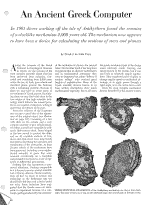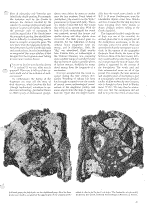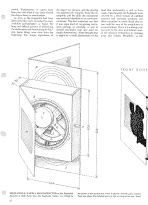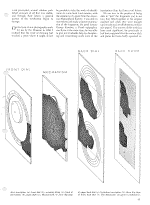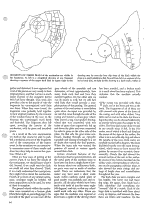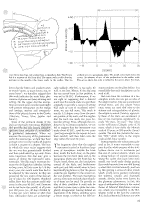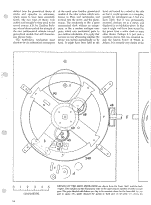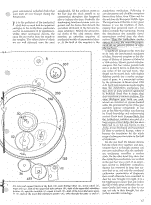|
by Derek J. de Solla Price Scientific American June 1959 p.60-7 from RupertRussell Website
Because of them we may have to revise many of our estimates of Greek science.
By studying them we may find
vital clues to the true origins of that high scientific technology
which hitherto has seemed peculiar to our modern civilization,
setting it apart from all cultures of the past.
Consisting of a box with dials on the outside and a very complex assembly of gear wheels mounted within, it must have resembled a well- made 18ih-century clock. Doors hinged to the box served to protect the dials, and on all available surfaces of box, doors and dials there were long Greek inscriptions describing the operation and construction of the instrument.
At least 20 gear wheels of the mechanism
have been preserved, including a very sophisticated assembly of
gears that were mounted eccentrically on a turntable and probably
functioned as a sort of epicyclic or differential, gear-system.
It could be argued that if the Greeks knew the
principle of gearing, they should have had no difficulty in
constructing mechanisms as complex as epicyclic gears. We now know
from the fragments in the National Museum that the Greeks did make
such mechanisms, but the knowledge is so unexpected that some
scholars at first thought that the fragments must belong to some
more modern device.
To authenticate the dating of the
fragments We must. tell the story of their discovery, which involves
the first (though inadvertent) adventure in underwater archaeology.
Just before Easter in 1900 a party of Dodecanese sponge-divers were
driven by storm to anchor near the tiny southern Greek island of Antikythera (the accent is on the "kyth," pronounced to rhyme with
pith).
With the help of Greek archaeologists the wreck was
explored; several fine bronze and marble statues and other objects
were recovered. The finds created great excitement, but the
difficulties of diving without heavy equipment were immense, and in
September, 1901, the "dig' was abandoned. Eight months later
Valerios StaÎs, an archaeologist at the National Museum, was
examining some calcified lumps of corroded bronze that had been set
aside as possible pieces of broken statuary. Suddenly he recognized
among them the fragments of a mechanism.
From the inscriptions and the dials the mechanism was correctly
identified as an astronomical device. The first conjecture was that
it was some kind of navigating instrument perhaps an astrolabe (a
sort of circular star-finder map also used for simple observations).
Some thought that it might be a small planetarium of the kind that
Archimedes is said to have made.
The success of this work has been most significant, for previously it had been supposed that the various dials and plates had been badly squashed together and distorted. It now appears that most of the pieces are very nearly in their original places, and that we have a much larger fraction of the complete device than had been thought.
This work also provides a clue to the
puzzle of why the fragments lay unrecognized until StaÎs saw them.
When they were found, the fragments were probably held together in
their original positions by the remains of the wooden frame of the
case. In the Museum the waterlogged wood dried and shrivelled. The
fragments then fell apart, revealing the interior of the mechanism,
with its gears and inscribed plates. As a result of the new
examinations we shall in due course be able to publish a technical
account of the fragments and of the construction of the instrument.
In the meantime we can tentatively summarize some of these results
and show how they help to answer the question. What is it?
On one side of the plate we can trace all the gear wheels of the assembly and can determine, at least approximately, how many teeth each had and how they meshed together. On the other side we can do nearly as well, but we still lack vital links that would provide a complete picture of the gearing. The general pattern of the mechanism is nonetheless quite clear. An input was provided by an axle that came through the side of the casing and turned a crown-gear wheel.
This moved a big, four-spoked
driving-wheel that was connected with two trains of gears that
respectively led up and down the plate and were connected by axles
to gears on the other side of the plate. On that side the
gear-trains continued, leading through an epicyclic turntable and
coming eventually to a set of shafts that turned the dial pointers.
When the input axle was turned, the pointers all moved at various
speeds around their dials.
All the gear wheels have been made with
teeth of just the same angle (60 degrees) and size, so that any
wheel could mesh with any other. There are signs that the machine
was repaired at least twice; a spoke of the driving wheel has been
mended, and a broken tooth in a small wheel has been replaced. This
indicates that the machine actually worked.
Very little can be read on the dials, but there is hope that they can be cleaned sufficiently to provide information that might be decisive. The front dial is just clean enough to say exactly what it did. It has two scales, one of which is fixed and displays the names of the signs of the zodiac; the other is on a movable slip ring and shows the months of the year. Both scales are carefully marked off in degrees.
The front dial fitted exactly over the
main driving-wheel, which seems to have turned the pointer by means
of an eccentric drum-assembly. Clearly this dial showed the annual
motion of the sun in the zodiac. By means of key letters inscribed
on the zodiac scale, corresponding to other letters on the parapegma
calendar plate, it also showed the main risings and settings of
bright stars and constellations throughout the year.
On the upper dial the inscriptions are
much more crowded and might well present information on the risings
and settings, stations and retrogradations of the planets known to
the Greeks (Mercury, Venus, Mars, Jupiter and Saturn).
The way in which the error varies suggests that the arc was first geometrically divided and then subdivided by eye only. Even more important, this dial may give a means of dating the instrument astronomically.
The slip ring is necessary because the
old Egyptian calendar, having no leap years, fell into error by 1/4
day every year; the month scale thus had to be adjusted by this
amount. As they are preserved the two scales of the dial are out of
phase by 13½ degrees. Standard tables show that this amount could
only occur in the year 80 B.C. and (because we do not know the
month) at all years just 120 years (i.e., 30 days divided by 1/4 day
per year) before or after that date.
This mark is exactly 1/2 degree away
from the present position of the scale, and this implies that the
mark was made two years before the setting. Thus, although the
evidence is by no means conclusive, we are led to suggest that the
instrument was made about 82 B.C., used for two years (just long
enough for the repairs to have been needed) and then taken onto the
ship within the next 30 years.
The main inscriptions are in a sorry state and only short snatches of them can be read. To provide an idea of their condition it need only be said that in some cases a plate has completely disappeared, leaving behind an impression of its letters, standing up in a mirror image, in relief on the soft corrosion products on the plate below.
It is remarkable that such
inscriptions can be read at all.
Putting together the information gathered so far, it seems reasonable to suppose that the whole purpose of the Antikythera device was to mechanize just this sort of cyclical relation, which was a strong feature of ancient astronomy.
Using the cycles that have been mentioned, one could easily design gearing that would operate from one dial having a wheel that revolved annually, and turn by this gearing a series of other wheels which would move pointers indicating the sidereal, synodic and draconitic months.
Similar cycles were known for the planetary phenomena; in fact, this type of arithmetical theory is the central theme of Seleucid Babylonian astronomy, which was transmitted to the Hellenistic world in the last few centuries B.C. Such arithmetical schemes are quite distinct from the geometrical theory of circles and epicycles in astronomy, which seems to have been essentially Greek.
The two types of theory were unified and
brought to their peak in the second century A.D. by Claudius
Ptolemy, whose labors marked the triumph of the new mathematical
attitude toward geometrical models that still characterizes physics
today.
I feel it is more likely that it was
permanently mounted, perhaps set in a statue, and displayed as an
exhibition piece. In that case it might well have been turned by the
power from a water clock or some other device. Perhaps it is just
such a wondrous device that was mounted inside the famous Tower of
Winds in Athens. It is certainly very similar to the great
astronomical cathedral clocks that were built all over Europe during
the Renaissance.
Behind the astronomical clocks of the 14th century there stretches an unbroken sequence of mechanical models of astronomical theory. At the head of this sequence is the Antikythera mechanism. Following it are instruments and clocklike computers known from Islam, from China and India and from the European Middle Ages.
The importance of this line is very great, because it was the
tradition of clock- making that preserved most of man's skill in
scientific fine mechanics. During the Renaissance the scientific
instrument-makers evolved from the clockmakers. Thus the Antikythera
mechanism is, in a way, the venerable progenitor of all our present
plethora of scientific hardware.
This design can be traced back, with slightly different periods but a similar arrangement of gears, to a manuscript written by the astronomer al-Biruni about 1000 A.D. Such instruments are much simpler than the Antikythera mechanism, but they show so many points of agreement in technical detail that it seems clear they came from a common tradition.
The same 60-degree gear teeth are used;
wheels are mounted on square-shanked axles; the geometrical layout
of the gear assembly appears comparable. It was just at this time
that Islam was drawing on Greek knowledge and rediscovering ancient
Greek texts. It seems likely that the Antikythera tradition was part
of a large corpus of knowledge that has since been lost to us but
was known to the Arabs. It was developed and transmitted by them to
medieval Europe, where it .became the foundation for the whole range
of subsequent invention in the field of clockwork.
History has contrived to keep that current dark to us, and only the accidental underwater preservation of fragments that would otherwise have crumbled to dust has now brought it to light.
It is a bit frightening to know that just
before the fall of their great civilization the ancient Greeks had
come so close to our age, not only in their thought, but also in
their scientific technology.
|

